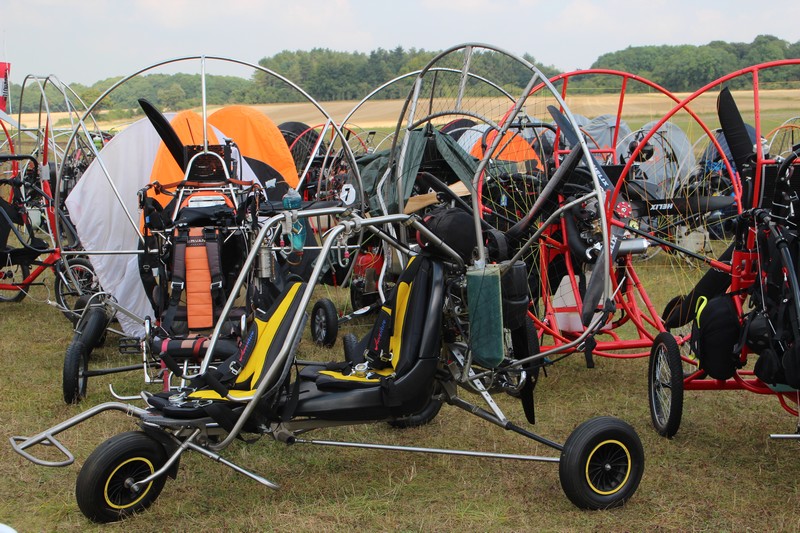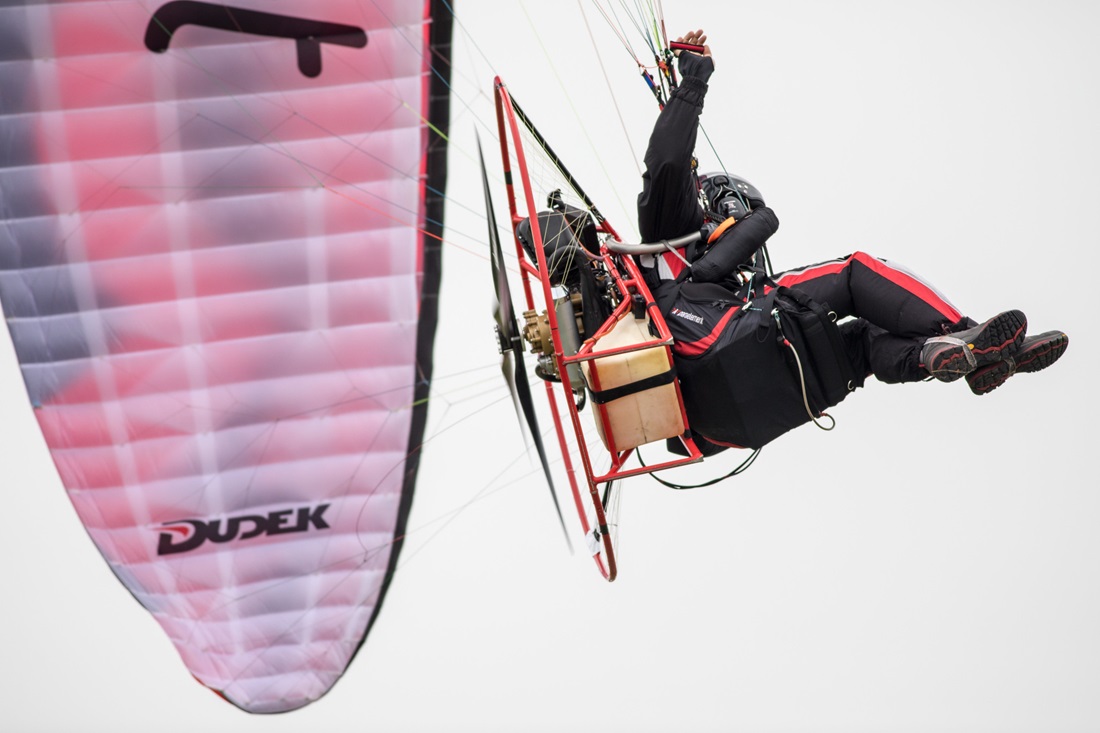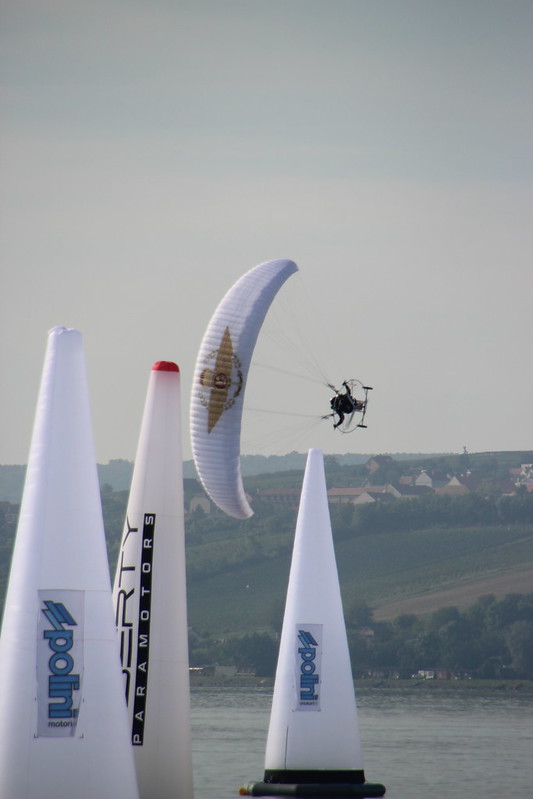FAI Microlight and Paramotor Commission (CIMA)
Paramotors
what is a paramotor?
Paramotoring is also known as 'Powered Paragliding'.
To fly, the pilot sits in a harness to which is attached a lightweight frame supporting a small engine, a two or three blade propellor and a wing similar to a paraglider wing, connected by lines attached to the harness. A cage around the propellor protects the lines from becoming entangled.
With the assistance of the motor, a paramotor pilot does not require an elevated position to take off, as a paraglider does.
There are two ways to launch a paramotor:
- Foot launch, in which the pilot runs to gain speed.
- Trike, where a small, wheeled vehicle attached to the harness helps the pilot to gather speed.
The pilot runs the engine whilst running or rolling, and the forward motion drives air into the cells of the wing, generating the lift required to take off.

Trike paramotors at the 9th FAI World Paramotor Championships, 2016. Credit: Wolfgang Lintl
A brief introduction to paramotors
In the early 1980s, inspired by the revolution in free flight and paragliding, British pilot Mike Byrne sought to invent a powered flying unit to be used in conjunction with a paragliding wing. His experiments led him to develop a model that he named a ‘paramotor’. This lightweight but powerful system was designed for ease of launch and sustained flight without the reliance on thermal lift.
A handful of commercial enterprises picked up on the idea and developed ever more sophisticated equipment, bringing the sport of paramotoring to a wider audience.
Initially, the engines used had been adapted from other motorised equipment, and adopted paraglider wings. As lighter, more powerful and reliable engines were designed specifically for the new sport, pilots gained the opportunity to fly longer distances. Likewise, specialist wings optimised for the speed of paramotor flight offered better lift, control, stability and manoeuvrability.
About Paramotor Competitions
The 1st FAI World Paramotor and Microlight Championships took place in South Africa in 1996. FAI Paramotor World Championships and FAI Paramotor Slalom Championships are sometimes held in conjuction with FAI Microlight World Championships.
Paramotor competitions have also featured at The World Air Games in Dubai in 2015, and at The World Games in Poland in 2017.
World championships also exist specifically for Paramotor Slalom which is held over water for safety, as pilots navigate around inflatable pylons.
In 2024, Great Britain hosts the first Endurance Paramotor championships, a new type of competition focusing on strategy.
Paramotor classes:
- Powered Paragliding - RPL 1 T (Paraglider Control / Landplane / Flown solo)
- Powered Paragliding - RPL 2 T (Paraglider Control / Landplane / Flown with two persons)
- Powered Paragliding - RPF 1 T (Paraglider Control / Foot-launched / Flown solo)

A solo foot-launch pilot at The World Games 2017. Credit: Marcus King/FAI
How do tasks and scoring work?
Paramotor competition tasks are set from the CIMA Task Catalogue.
In a classic World Paramotor Championships, tasks are selected from Navigation, Economy and Precision categories for solo and two-person trike, and solo foot launch classes.
In slalom, pilots in PF-1 and PL-1 categories must navigate pre-designated routes around up to five inflatable pylons, starting and finishing between the gates.
For the new Endurance Paramotor championships, solo foot-launch and trike will be contested, with a focus on personal flight planning, airborne decisions and practical paramotoring and piloting skills. Principle task points are available for precision navigation and some may also require pre-declared speed elements. Bonus task points are available for collecting turn points en route to and from precision tasks, and performing precision landings in designated areas.

Competitor at the 4th FAI World Slalom Paramotor Championships 2022, Czechia
Credit: Wolfgang Lintl
What does the FAI Microlight and Paramotor Commission do?
The FAI Microlight and Paramotor Commission (CIMA, whose acronym is from the French name, Comité International de Micro Aviation) was established in 1981, as part of the FAI (World Air Sports Federation) to support and develop the sport, and provide administration for rules changes, sporting events, awards and records.
In 2010, the Commission was renamed the FAI Microlight & Paramotor Commission.
The CIMA bureau meets annually when elections take place, and welcome delegates from FAI member countries. Subcommittees and Working Groups undertake studies and provide reports on specific topics.
There is an FAI Sporting Code for Microlights which is updated regularly as the sport develops.
Paramotor Awards
FAI Colibri Badges recognise standards of achievements in paramotor piloting at four levels: Bronze, Silver, Gold and Diamond, to recognise for example, competition performance or distance flights.
One of the two FAI Ann Welch Diplomas which may be awarded each year applies to paramotor pilots: for a meritorious flight which resulted in a Paramotor world record claim ratified in the year in question.
Paramotor Records
The FAI Microlight and Paramotor Commission supports record attempts and ratifies record claims. The first FAI paramotor world record was set in 1995 by Laureano Casado Tirado for ‘Distance in a closed circuit without landing’, with 179.40km.
Records can be set for altitude, speed or distance over a straight course or closed circuit. Absolute records in paramotor are for fastest paramotor, from any speed related category, greatest paramotor distance, in any category, and highest paramotor, in any altitude category.
Header image: Marcus King at The World Games 2017

